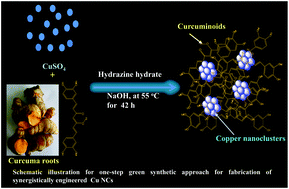当前位置:
X-MOL 学术
›
New J. Chem.
›
论文详情
Our official English website, www.x-mol.net, welcomes your
feedback! (Note: you will need to create a separate account there.)
One-step eco-friendly approach for the fabrication of synergistically engineered fluorescent copper nanoclusters: sensing of Hg2+ ion and cellular uptake and bioimaging properties†
New Journal of Chemistry ( IF 2.7 ) Pub Date : 2017-12-13 00:00:00 , DOI: 10.1039/c7nj04031h Jigna R. Bhamore 1, 2, 3, 4 , Balaji Deshmukh 4, 5, 6, 7, 8 , Varun Haran 4, 5, 6, 7, 8 , Sanjay Jha 4, 9, 10, 11 , Rakesh Kumar Singhal 4, 12, 13, 14 , Nibedita Lenka 4, 5, 6, 7, 8 , Suresh Kumar Kailasa 1, 2, 3, 4 , Z. V. P. Murthy 2, 4, 11, 15
New Journal of Chemistry ( IF 2.7 ) Pub Date : 2017-12-13 00:00:00 , DOI: 10.1039/c7nj04031h Jigna R. Bhamore 1, 2, 3, 4 , Balaji Deshmukh 4, 5, 6, 7, 8 , Varun Haran 4, 5, 6, 7, 8 , Sanjay Jha 4, 9, 10, 11 , Rakesh Kumar Singhal 4, 12, 13, 14 , Nibedita Lenka 4, 5, 6, 7, 8 , Suresh Kumar Kailasa 1, 2, 3, 4 , Z. V. P. Murthy 2, 4, 11, 15
Affiliation

|
Herein, a single-step eco-friendly synthetic method was established for the fabrication of synergistically engineered fluorescent copper nanoclusters (Cu NCs) using curcuma root (Curcuma longa L.) extract (curcuminoids) as a template. These Cu NCs are water-soluble and emitted bright blue fluorescence under UV light illumination at 365 nm. The synergistically engineered Cu NCs exhibited an emission peak at 440 nm with quantum yield of 7.2%. Due to their optical properties, a new fluorescent analytical strategy has been developed for the sensing of Hg2+ ions and used to evaluate cellular uptake and bioimaging properties on cancer cells (RIN-5F and MDAMB231) and fungal cells (Penicillium citrinum). It was interestingly observed that Hg2+ ion effectively quenched the emission peak of Cu NCs at 440 nm, which indicates that Cu NCs act as a fluorescent sensor. Taking advantage of this, a novel fluorescent Hg2+ sensor has been established, which showed a linear range of 0.0005–25 μM with a detection limit of 0.12 nM at room temperature. Furthermore, Cu NCs exhibited good selectivity for Hg2+ against other inorganic species, and the potentiality of the method was demonstrated by detecting Hg2+ ions in water samples. Furthermore, Cu NCs act as probes for imaging of two cancer cells (RIN-5F and MDAMB231) and fungal cells (Penicillium citrinum), and the cell viability results reveals their nontoxic nature.
中文翻译:

协同设计荧光铜纳米簇的一步式环保方法:检测Hg 2+离子以及细胞摄取和生物成像特性†
在此,建立了一种以一步一步的环保合成方法,以姜黄根(Curcuma longa L.)提取物(姜黄素)为模板,协同制备荧光铜纳米簇(Cu NCs)。这些Cu NCs是水溶性的,在365 nm的紫外线照射下发出亮蓝色荧光。协同设计的Cu NCs在440 nm处显示出发射峰,量子产率为7.2%。由于它们的光学特性,已开发出一种新的荧光分析策略来检测Hg 2+离子,并用于评估癌细胞(RIN-5F和MDAMB231)和真菌细胞(柠檬青霉)的细胞摄取和生物成像特性。有趣的是,观察到Hg 2+离子有效地淬灭了440 nm处Cu NCs的发射峰,这表明Cu NCs充当荧光传感器。利用这一优势,已建立了新型荧光Hg 2+传感器,该传感器的线性范围为0.0005–25μM,在室温下的检测极限为0.12 nM。此外,Cu NCs对Hg 2+表现出对其他无机物的良好选择性,并且通过检测水样中的Hg 2+离子证明了该方法的潜力。此外,Cu NCs用作两种癌细胞(RIN-5F和MDAMB231)和真菌细胞(柠檬青霉)成像的探针,细胞活力结果揭示了它们的无毒性质。
更新日期:2017-12-13
中文翻译:

协同设计荧光铜纳米簇的一步式环保方法:检测Hg 2+离子以及细胞摄取和生物成像特性†
在此,建立了一种以一步一步的环保合成方法,以姜黄根(Curcuma longa L.)提取物(姜黄素)为模板,协同制备荧光铜纳米簇(Cu NCs)。这些Cu NCs是水溶性的,在365 nm的紫外线照射下发出亮蓝色荧光。协同设计的Cu NCs在440 nm处显示出发射峰,量子产率为7.2%。由于它们的光学特性,已开发出一种新的荧光分析策略来检测Hg 2+离子,并用于评估癌细胞(RIN-5F和MDAMB231)和真菌细胞(柠檬青霉)的细胞摄取和生物成像特性。有趣的是,观察到Hg 2+离子有效地淬灭了440 nm处Cu NCs的发射峰,这表明Cu NCs充当荧光传感器。利用这一优势,已建立了新型荧光Hg 2+传感器,该传感器的线性范围为0.0005–25μM,在室温下的检测极限为0.12 nM。此外,Cu NCs对Hg 2+表现出对其他无机物的良好选择性,并且通过检测水样中的Hg 2+离子证明了该方法的潜力。此外,Cu NCs用作两种癌细胞(RIN-5F和MDAMB231)和真菌细胞(柠檬青霉)成像的探针,细胞活力结果揭示了它们的无毒性质。











































 京公网安备 11010802027423号
京公网安备 11010802027423号